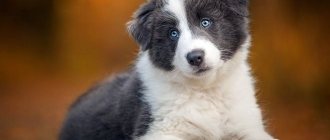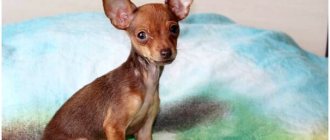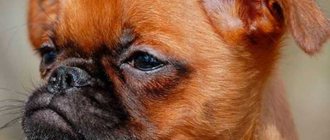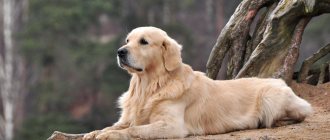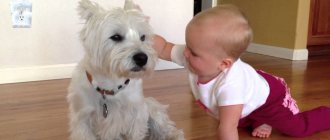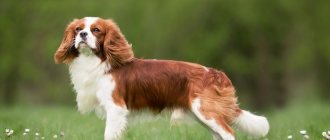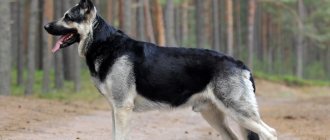A miniature and playful dog with the habits of an affectionate cat, it is considered the best companion for families with children or those living in an apartment. The Japanese Chin is distinguished by its easy-going character and graceful appearance, calm disposition and good health. Dog breeders love this breed for its cleanliness and unobtrusiveness.
Description of the Japanese Chin breed
If you can’t decide what kind of pet to get, then pay attention to a small dog native to Japan. In behavior, she resembles a cat, often washes herself with her paw, is very clean, loves to lie on her owner’s lap, and climbs into closets or cabinets in search of a cozy place to rest. The description of the Japanese Chin indicates that few people will remain indifferent to this mischievous little one. Outdoor games bring pleasure to dogs at different ages. A calm and easy-going disposition allows you to train your pet, but only if it is interesting to him.
History of the Japanese Chin breed
The dog is considered one of the oldest. Archaeologists in the Gobi Desert have found the remains of a dwarf animal, presumably from which the Japanese Chin dog breed came. There are two main theories of origin. According to one of them, the Chinese people paid tribute to Japan, which necessarily included small playful dogs. Another says that they were brought by Buddhist monks as a gift to the emperor.
Until 1977, the breed was called the Japanese spaniel. The chin was a rare animal that was considered a sacred messenger. It could not be bought, but only received as a gift. Only people close to the ruler owned dogs. In the 19th century traders brought the animal to the mainland for the first time. This is how Japanese Chins appeared in Europe and America. The first owner of the breed was President Franklin.
Japanese Chin breed standard
The dog's appearance has remained unchanged since the time they were kept in the imperial palace. There are standards by which pets are divided into dwarf and ordinary. Otherwise, the Japanese Chin dog has its own distinct features, thanks to which it cannot be confused with any similar breed, even with the Pekingese. External characteristics:
- weight – 3-5 kg;
- height – 22-26 cm;
- the head is large with widely spaced eyes;
- short, drooping triangular ears;
- wide flat nose, black or brown;
- tail thrown over the back or side with hanging hair;
- the length of the body is equal to the height of the animal at the withers;
- color white with brown, red or black spots on the ears and body;
- The coat is long and smooth.
Personality of the Japanese Chin
Thanks to its personality, the dog easily adapts to its owner and does not cause any trouble. In a quiet and calm environment, he behaves appropriately - he does not make noise and does not bother with overly active games. If the family, on the contrary, is always seething with energy, then the dog will be active, playful and requiring constant attention. Sometimes the Japanese Chin breed can exhibit a proud and willful character, so it is not advisable to have one if there are toddlers in the house. They can pull the tail, ears, hurt, to which the dog will respond with aggression, but this happens rarely.
Chins are mischievous and cheerful from a young age, they love to jump and play, but at the same time they behave calmly and judiciously in the appropriate environment. Friendliness also manifests itself towards strangers and animals. The character of the Japanese Chin is often compared to the behavior of Buddhist monks - just as reasonable, calm, and striving for harmony with the outside world.
Japanese Chin colors
The breed standard distinguishes only two types of colors.
- The most common Japanese Chin is black and white. The spots can be scattered throughout the body, sometimes symmetrically. Dogs that have black hair in the form of a mask around the eyes, and a white stripe running from the nose to the back, widening on the back, are of high value.
- With white with red spots, the color can vary from very light lemon to rich orange or brownish.
- Any deviation from these two types of colors, for example, tri-colored individuals, is considered a breed culling.
How much a Japanese Chin costs will largely depend on the color standard. If there are deviations, the price is immediately reduced several times. In nurseries, an animal with documents costs from $500 to $1000. You can buy it from your own hands much cheaper - about $40-100, but the dog is unlikely to be able to participate in exhibitions, because such owners do not have documents, which does not allow confirming the purebred of the breed.
Japanese Chin and Pekingese - differences
Often, out of ignorance, people confuse these two breeds due to their external similarity. After birth, a small Pekingese and a Japanese Chin puppy are very similar. The latter are often born with a single color, and only with age do spots appear on the coat. If you look closely, you can see that the Pekingese is different:
- It has a thick undercoat and a coarser coat.
- The color is monochromatic - brown, black, red, tan, ash or chocolate. There is also a mixture of several colors.
- The coat is thick, long, and sometimes slightly wavy.
- The Pekingese's muzzle is larger, snub-nosed and short, with a pronounced crease around the nose.
- The length of the body is greater than the height at the withers.
- The front legs are shorter than those of the Chin. In the area of the collarbones they are widely spaced, which is why they appear a little crooked.
What will the old-type Pekingese tell you?
Naturally, the enormous popularity of the Pekingese caused the appearance of various kinds of people who, wanting to get rich, were not very worried about the purebred of the breed. There is such a thing as the old-type Pekingese .
Externally, the dog resembles a Pekingese, but does not at all meet modern standards for the breed. As a rule, these are half-breeds . On the one hand, Pekingese blood flows in their veins, and on the other... Let's look at some of them.
Pickup or Pominese is a cross between a Pekingese and a Spitz . This is a wonderful dog in all appearances, which is distinguished by intelligence, playfulness, endurance, and also a rather attractive appearance; affectionate, sociable, but does not recognize loneliness. Left alone, he destroys everything around him in the literal sense of the word.
Pekingese and pug are dogs that only at first glance seem similar. Although the pug is considered a close relative of the Pekingese and Japanese Chin.
These breeds are similar to each other. A pug-Pekingese mix does not promise anything bad. This cute little dog will definitely incorporate the traits of both breeds, and they are mostly positive.
Pekingese mixed breed - Shinese , which is obtained from the combination of Pekingese and Shih Tzu . This has been done frequently in the past in an attempt to influence the length of the Pekingese's coat.
Important! Dogs of this breed snore when they sleep. But this is inherent in nature and should not bother the owner.
These are also small dogs with bulging eyes like those of a Pekingese . Their fur is black, brindle, golden, sable or white. They, like their parents, are small in stature .
Shinese dogs almost never shed , except that if the puppy inherits the traits of a Pekingese dog, then there will be shedding, albeit insignificant. They are also distinguished by their intelligence, friendliness and flexible character.
They say that mixed breeds are inherently dogs that are much better than their parents . And it is true. The advantage of this union is the offspring, which are in good health. But in appearance the puppies are not an acquired taste. And in this case you will have to forget about exhibitions.
In conclusion, it must be emphasized that both Arlik and all types of Pekingese crosses of this wonderful dog cannot be classified as a purebred breed. They have the right to be, and in some ways they even surpass their famous relatives. However, such dogs are not allowed for exhibitions or breeding.
And if we talk about standards and purebredness, then among the Pekingese there are no varieties . Therefore, if you hear the phrase “Royal Pekingese” or “Imperial Pekingese”, know that we are simply talking about a representative of this wonderful breed.
Pros and cons of Japanese Chin
To avoid any unpleasant surprises, before getting yourself a pet, you need to carefully study all the features of the pet. The Japanese Chin toy dog breed has the following advantages:
- Gets along well with other pets.
- Obedience and intelligence are valued by dog handlers, who rank them among the most trainable of small dogs.
- Wool does not require frequent washing and careful care.
- They never bark for no reason, so they won’t cause trouble for neighbors in the apartment.
The Japanese Chin breed also has disadvantages, which sometimes become decisive when deciding to buy a dog:
- They do not tolerate loneliness well and become very attached to their owner. If you lack attention for a long time, you can literally get sick.
- Due to the structure of the skull and the location of the nose, seizures occur. A dog may begin to choke after an emotional shock, excessive joy, physical exertion, or sudden temperature changes.
- Due to the structure of the eyes, the animal can easily injure them. They require regular treatment to avoid infection.
Diseases and their prevention
Overall, the Japanese Chin is a healthy breed. The most common diseases that occur are those to which almost all decorative dogs are predisposed.
Table: diseases of Japanese Chin
| Disease | Description of the disease | Treatment |
| Glaucoma | With this disease, intraocular pressure increases. Most often it develops due to mechanical injury to the eye or heat stroke. | Medicines are prescribed by a veterinarian after examining the dog. |
| Eyeball luxation | Occurs due to incomplete closure of the bone tissue of the orbit in the chin | Treatment is only surgical. In case of primary injury, you can save the dog’s vision if you take it to the veterinary clinic in time |
| Cataract | This eye disease develops mainly in older dogs and is accompanied by clouding of the lens of the eye. | The intensity and need for therapy is determined by a specialist |
| Brachycephalic syndrome (nostril stenosis) | The disease is a narrowing of the nasal passages. In combination with a shortened muzzle, it can lead to serious breathing problems | During a walk, you should not force your pet to run around a lot, especially in hot weather. It is necessary to give him a break. You should also regularly take your dog to the veterinarian for preventive examinations. |
| Tracheal collapse | The problem occurs most often in Japanese Chin mixes and other small breeds of dogs. Adults and puppies suffer from attacks of reverse sneezing, which, in combination with reduced flexibility of the trachea, leads to narrowing and blockage of the airways | To prevent the trachea from narrowing, it must be strengthened with a mesh (stented). The procedure is carried out in a veterinary hospital |
| Congenital dislocation of the kneecap | Dislocation occurs when intrauterine development is disrupted. A puppy may look completely healthy, but be prone to sprains. In advanced cases, the chin is unable to lean on the injured paw | The problem can be partially solved by reduction or surgery followed by treatment. The dog should be protected from excessive physical exertion, since an increased tendency to dislocations remains even after surgery. |
| Arthritis | The disease is an inflammation of the joints, and older quinines are susceptible to it. | Treatment is carried out using medications prescribed by a veterinarian, special exercises and physical procedures. |
Japanese Chins do not tolerate anesthesia well. Anesthesia must be used with great caution.
The average life expectancy of the breed is 12 years. With proper care, a dog can live up to 16 years. Proper care consists of routine vaccinations, timely preventive examinations by a veterinarian and regular helminthization.
How to care for a Japanese Chin?
The owners of this playful miniature dog are lucky. Pets do not require special care like other capricious breeds. Japanese Chin adults and puppies need the following:
- weekly ear cleaning;
- eye treatment;
- nail trimming;
- brushing teeth and regularly removing tartar and plaque;
- compliance with diet;
- timely implementation of preventive vaccinations against dangerous diseases;
- combing – 1-2 times a week;
- bathing - once every 1-2 months. and as pollution occurs;
- daily paw toilet after a walk.
What to feed your Japanese Chin?
The dog is not picky when it comes to food; the main thing is to follow a regular and balanced diet. In order for the red or black Japanese Chin to remain healthy, full of strength with a bright and shiny coat, its daily menu should include the following foods:
- lean meat - turkey, beef, chicken;
- by-products – liver, kidneys, lung, tripe;
- fermented milk products;
- fresh, stewed or boiled vegetables;
- vegetable oil;
- fish;
- eggs;
- fruits – green apple, pear;
- porridge.
An adult dog needs about 120 ml of food per day. Allergy sufferers are common among the Japanese Chin breed, so the choice of food is individual. You cannot feed your animal the following foods:
- baked goods, candies and any sweets;
- fatty and fried foods;
- pork;
- smoked meats;
- seasonings and spices;
- salty foods;
- fatty fermented milk products - sour cream, hard cheese, cream;
- bones;
- potatoes;
- legumes
Japanese Chin – coat care
Mischievous dogs do not require exhausting daily combing and washing. However, you still can’t do without standard care:
- Chin should be washed no more than once a month if it is heavily soiled, otherwise itching will occur due to dry skin. In winter, when there is no slush on the street - once every 3-4 months. You should only bathe with special shampoos for long-haired dogs in warm water. The following brands are considered popular: “8in1 Tea Tree oil Shampoo” or “Doctor Zoo”. Dry the wool with a hairdryer or naturally.
- During shedding, you will have to comb your pet 1-2 times a week in problem areas - behind the ears and between the paws.
- Chin does not need a decorative haircut. Dog breeders claim that this can ruin the quality of the coat. At the same time, regular hygienic cutting of the Japanese Chin is required. To do this, the hair in the genital area, on the stomach, in male dogs, and on the paws is shortened. This prevents it from getting dirty and becoming tangled.
Appearance
Japanese Chins square format. These dogs are muscular with a dry constitution. At the withers from 18 to 25 cm and from 2 to 4 kg. Males are larger than females. Dogs have a jumping gait.
The head is round and quite large. The skull has a convex shape. When transitioning from the forehead to the muzzle, there is a deep stop. The nose is upturned with open nostrils. It is often black, but also flesh-colored. The eyes are set wide. They are convex and dark. The whites are clearly visible in the corners, which gives the muzzle a naive, surprised expression.
The muzzle is short and wide. The jaws are strong. The bite is either straight or with an overbite. When the dog's mouth is closed, no teeth or tongue should be visible.
The ears are wide set and triangular in shape. Long. The body is slightly elongated. The lower back has a slight curve, but the back is straight.
The paws are thin and long, stand parallel to each other, shaped like a hare's and with tassels. The dogs look exquisite.
The fur is quite long. Falls in silken strands. More hair behind the ears, on the collar (males have a mane), tail and back of the legs. Red or black spots are located quite symmetrically on the snow-white background of the coat. Red can be anything from brown to light lemon. The spots are clearly defined. It’s gorgeous when there’s a clear white mark on the forehead.
Clothing for the Japanese Chin
In winter or autumn, when the street is dirty and slushy, the dog needs protection. Currently you can purchase the following clothes:
- To prevent their fur from getting dirty, they are dressed in overalls.
- In severe frosts, due to the lack of undercoat, the standard or dwarf Japanese chin can freeze, then they need warm clothing.
- To protect paws from the chemicals that are sprinkled on roads in winter, special boots are sold.
Breed traits
Breed traits (on a 5-point scale)
| Pekingese | |||
| Activity | in the house | 2.8 | |
| on the street | 3 | ||
| Obedience | training | 2.5 | |
| strangers | 3.5 | ||
| Domination | in family | 2.8 | |
| over dogs | 3.5 | ||
| Defending your territory | from people | 3.5 | |
| from dogs | 3.5 | ||
| Sociability | in family | 4.8 | |
| with strangers | 3.3 | ||
| with dogs | 3 | ||
| Concentration | in family | 1.3 | |
| in front of strangers | 3 | ||
| with dogs | 2.8 | ||
| Aggressiveness | in family | 1.5 | |
| to strangers | 2.3 | ||
| to the dogs | 3 | ||
| to cats | 3 | ||
| Family behavior | calmness | 3 | |
| demand for affection | 4 | ||
| excitability | 3.8 | ||
| playfulness | 3.8 | ||
| excessive barking | 2 | ||
| behavioral breakdowns | 1.5 | ||
| Tolerance for children | up to 4 years | 2.8 | |
| over 4 years old | 3.8 | ||
| Institutional use | watchman | 3.5 | |
| bodyguard | 2.3 | ||
This breed is often compared to the following dog breeds: Pug, Shih Tzu, Yorkshire Terrier, Pomeranian, Chihuahua.
Muzzle
Group photo
Japanese Chin – training
Dog handlers consider this breed to be the most trainable among the decorative ones. The main thing is that they have fun during training. Regularly, for 5-15 minutes. You need to conduct classes with your pet every day, then he will easily remember and will happily follow commands. The Japanese Chin is a wayward dog; if he gets bored or is not in the mood, then nothing will work out. Compliance with these conditions will help in training:
- Nothing should distract the dog's attention.
- After successfully completing the command, be sure to reward your pet with a treat.
- Any action must be practiced until it works several times in a row.
- Each lesson needs to reinforce the commands already learned.
- Exercise only when you feel good and are in a good mood.
Character
Dogs are intellectuals, capable of listening carefully and understanding their owner. With a subtle sense of humor. The voice is like meowing or the babbling of a spring stream. They greet the owner, rise on their hind legs and playfully move their front legs.
Communicate with your chin and he will not be jealous of your other pets or be capricious. Over the centuries, dogs have learned to subtly sense the mood of their owner and are called upon to maintain a harmonious and peaceful atmosphere in the house. After stroking a pet, the headache goes away, depression goes away, and some people feel the biofield normalize.
Diseases of the Japanese Chin breed
In order for an animal to live to 13-15 years, it is necessary to carefully monitor its health. The description of the Japanese Chin dog contains a list of diseases inherent in these cute four-legged friends. They are due to the structural features of the skeleton and body. Common diseases:
- Retinal atrophy and cataracts. At the first signs, the veterinarian prescribes a set of medications to prevent or slow down the development of the process.
- Heart failure and murmurs require special attention. Reducing physical activity and supporting medications will prolong the animal's life.
- Often the Japanese Chin suffocates due to overheating. You can't walk in the heat and sun.
- Necrosis of the femur requires timely surgical intervention.
Pekingese varieties
Among these dogs, due attention should be paid to dwarf or, as they are also called, sleeve (pocket), mini Pekingese . This is not a separate type of offspring, but a variety . Although they say that these dogs are more intelligent and playful than their “relatives”. By the way, it is possible to determine what exactly a dwarf Pekingese is only when it reaches eight months.
In general, you don’t need to hope that with the purchase of this miniature dog you will acquire the same puppies. This opinion is erroneous - small Pekingese can appear from a larger dog , which, as a rule, happens. You can often hear about the Royal Pekingese .
Dog breeders know well that there is no such breed . This is a kind of advertising trick of the unscrupulous - they invite the buyer. In fact, they are trying to foist a marriage. “Royal” is the name given to the common Pekingese , which deserves attention.
Important! These dogs should not be walked in the heat. The sun is deadly for them!
History of the origin of the Pekingese breed
Pekingese is one of the most ancient breeds, appearing more than 2000 years ago. Bred in China specifically for the emperor. No one but him had the right to keep such a dog. The Chinese called them Fu or Peking Palace Dog. According to legend, the origin of the Pekingese is unusual - they were descendants of a lion and a monkey. This explains the original appearance and proud independent character. Pekingese were considered sacred, people believed that they could ward off evil spirits and bring happiness. They were family members; when the emperor died, they were buried with him. Many images and figurines of such fluffy dogs were found in ancient tombs.
For a long time the breed was hidden, it was unknown in the world. Her fate was decided at the end of the 19th century. During the Opium War, soldiers from England stormed the imperial palace and discovered 5 dogs. They were taken to Great Britain, where they began to breed. The dogs became known as pekines because they were found in Beijing. At first they were kept only by members of the nobility; the breed was very rare. But by the beginning of the 20th century, it spread throughout Europe and gradually appeared in America. Clubs for Pekingese lovers began to be created, and the first breed standard appeared.
In China itself, with the communists coming to power, these dogs were considered a relic of the past and began to be destroyed. But thanks to the fact that by this time the breed had already spread throughout the world, it was saved from extinction. Now this is one of the most popular decorative dogs. During the selection process, breeders tried to preserve the breed characteristics, although this was difficult to do due to the small number of individuals. Therefore, modern Pekingese look a little different from the ancient representatives of the breed. They are larger, heavier, their legs are shorter, and their muzzle is more flattened. But these dogs retained their lion's mane and proud gait.
Interesting Facts
The world learned about this ancient breed only in the 19th century. But now many facts are known about what it was like before:
- in ancient China, only members of the nobility could keep such dogs;
- Pekingese were considered sacred dogs, ordinary people were forbidden to even look at them, and they were executed for theft;
- each dog had a servant, they were surrounded by care and fed from the imperial table;
- puppies were fed human breast milk;
- The external appearance of the Pekingese was strictly controlled; the dog had to be in harmony with the furniture and decorations in the palace.
Interesting ancient pictures showing the life of Pekingese in the imperial palace:
In the imperial palace
In the imperial palace

